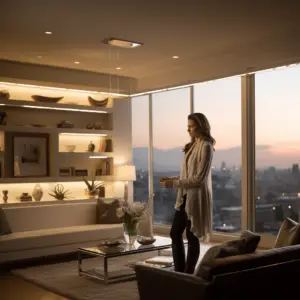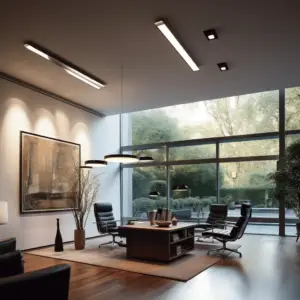Table of Contents
Introduction to Energy-efficient Lighting
Energy-efficient lighting has changed the way we light up our spaces. It uses less energy than traditional lighting sources, saving money and reducing carbon emissions. LEDs, CFLs, and halogen incandescent bulbs are all energy-efficient lighting options.
LEDs last up to 25 times longer than traditional bulbs, meaning less frequent replacements and lower maintenance costs. CFLs and LEDs also use less electricity than regular bulbs.
Switching to energy-efficient lighting can save you money on electricity bills. Plus, it decreases the demand for overall electricity, leading to a decrease in greenhouse gas emissions.
The history of energy-efficient lighting started in the early 1960s with the development of LEDs. Over time, LED technology has become more affordable and functional. Now, LEDs are used everywhere, from home lighting to commercial purposes. Governments worldwide are promoting the use of energy-efficient lighting to help the environment.
Choose energy-efficient lighting and enjoy the benefits of lower electricity costs and an eco-friendly lifestyle!
Benefits of Energy-efficient Lighting

To achieve the benefits of energy-efficient lighting, explore the lower energy consumption achieved through this method. Additionally, discover the reduced environmental impact and cost savings.
Lower Energy Consumption
Energy-efficient lighting is a must-have to save energy. Advanced tech and innovative designs make it possible to reduce energy used for lighting. This helps the environment and saves money on electricity bills. Plus, it contributes to reducing greenhouse gas emissions and fighting climate change.
For the full benefits of energy-efficient lighting, consider using LED bulbs instead of incandescent or fluorescent ones. LEDs convert most electricity into light and not heat, which saves energy and increases their lifespan.
To further optimize energy usage, install motion sensors or timers. These devices will turn off lights when no one is present or when natural light is enough.
Let’s seize the remarkable benefits of energy-efficient lighting and advance towards a greener future. From LEDs to CFLs, there are enough types to brighten up the home and the wallet!
Types of Energy-efficient Lighting
To gain a better understanding of types of energy-efficient lighting, explore LED lighting and CFL lighting. Focus on the benefits and features of each option, considering their energy-saving potential and durability. By examining LED lighting and CFL lighting, you can identify the most suitable choice for your needs and create an eco-friendly, cost-effective lighting solution.
LED Lighting
LED lights are a super energy-efficient option for residential and commercial use. They last up to 50 times longer than traditional bulbs – reducing the need for replacements and waste. Plus, LED lights have no harmful substances like mercury, so they’re better for human health and the environment.
To get the most out of LED lighting:
- Replace traditional bulbs with LEDs for maximum energy savings.
- Install dimmer switches to regulate brightness and conserve energy.
- Incorporate motion sensors or timers to only turn on lights when needed.
With these simple steps, you can make the most of LED lighting and reduce energy consumption in an innovative way! LED lighting: the perfect way to brighten up your room, save the planet, and make your electricity bill cry.
Advantages of LED Lighting
LED lighting is a popular choice for cost-saving and energy-efficient solutions. It has many advantages, including:
- Lower energy consumption, compared to traditional incandescent bulbs.
- A longer lifespan – up to 25 times longer than incandescent bulbs.
- Bright, focused illumination with a range of color options.
- No mercury or other harmful substances.
LED lights are also durable and shock-resistant. They are used in many sectors such as residential, commercial, and automotive. Energy.gov reports that completely switching to LED lights by 2027 could save the US over $30 billion in energy costs. CFL lights are the gold medalists in energy-saving!
CFL Lighting
Compact Fluorescent Lamp (CFL) Lighting is a type of energy-efficient lighting that utilizes fluorescent technology. It has many advantages and is used both in residential and commercial settings.
- CFLs are very energy-efficient, using only a fraction of the energy consumed by traditional incandescent bulbs.
- They last longer than incandescent bulbs, saving money and reducing waste.
- CFLs give off less heat, making them safer to use and cutting back on the stress on cooling systems.
- They produce as much light as traditional bulbs but run at lower wattages, further helping energy savings.
- CFLs come in various shapes and sizes, making them perfect for different lighting fixtures and applications.
What makes CFL Lighting special is its practical features. For instance, they work with dimmers, allowing users to change the intensity of light according to their needs. Also, CFL bulbs are suitable for existing light fixtures, no costly modifications needed.
Here are some tips to maximize the benefits of CFL Lighting:
- Change all incandescent bulbs to CFLs: This basic step can significantly reduce energy consumption and save on electricity bills. Replacing all outdated bulbs in your home or workplace with CFLs can lessen your carbon footprint while enjoying better lighting quality.
- Use daylight-colored CFLs for task-oriented areas: Daylight-colored CFL bulbs offer a cool white light that looks like natural daylight. This makes them great for places where exact tasks are done, such as offices or workstations.
- Be aware of disposal: Like any other electronic device, proper disposal of CFL bulbs is essential to avoid environmental harm. Recycling centers often accept used CFL bulbs since they have low mercury content. Be sure to follow local guidelines for safe disposal.
By following these tips, you can take full use of the energy-saving potential of CFL Lighting while enjoying improved illumination. Embrace this eco-friendly lighting option today and see the positive effect it has on your surroundings. Switching to CFL lighting is as smart as wearing sunglasses at night, conserving energy and our eyesight together.
Advantages of CFL Lighting
CFL lighting offers many advantages, such as energy efficiency and environmental sustainability. It consumes less energy than traditional incandescent bulbs, leading to lower electricity bills. Plus, it has a longer lifespan, so fewer replacements are needed. Furthermore, CFLs emit less heat, making them safer and reducing the load on cooling systems. They come in various color temperatures, giving you the freedom to customize according to your desired lighting. Plus, their warm, natural light closely resembles natural sunlight, creating an inviting atmosphere.
On top of that, CFLs are perfect for tight spaces since they are more compact. And they are compatible with dimmer switches, giving you greater control over the light intensity. To get the most out of CFL lighting, replace outdated incandescent bulbs with CFLs and properly recycle used ones. Doing this will help you save energy and money while promoting sustainability. So, let’s light the way to a more efficient future – because wasting energy is for amateurs!
Implementation of Energy-efficient Lighting
To implement energy-efficient lighting with retrofitting existing lighting systems and choosing energy-efficient lighting products as solutions.
Retrofitting Existing Lighting Systems
Retrofitting existing lighting systems is a must for energy-efficiency. Replacing old fixtures with more efficient options can cut energy consumption and lessen the carbon footprint. This not only helps save money but also the environment.
Here’s a five-step guide to retrofitting existing lighting systems:
- Assess current lighting: Start by analyzing the current setup to pinpoint areas that need improvement. Look at factors such as bulb type, wattage, and overall design.
- Choose energy-efficient alternatives: Research modern lighting technologies that are energy-efficient. LED lights are popular due to their durability and low energy demand.
- Plan the layout: Develop an efficient layout based on the specific needs of each area. Think about task performance, aesthetics, and ambient light levels.
- Install new fixtures: Make sure to follow safety guidelines and do proper wiring when installing the new lighting fixtures.
- Regular maintenance: Put in place a maintenance schedule to ensure the retrofitted lighting system is always working optimally. Cleaning, bulb changes, and inspections will extend the lifespan of the fixtures.
Retrofitting existing lighting systems is gaining attention. It helps reduce greenhouse gas emissions and energy usage, which is why it is now part of sustainable development plans worldwide. So, go for energy-efficient lighting products and help save the planet, one LED at a time.
Choosing Energy-efficient Lighting Products
Choosing the perfect energy-saving lighting products is essential for cutting energy use and sustaining sustainability. Here are some key points to remember:
- Go for LED bulbs. LED lights use significantly less energy and can last for longer than traditional incandescent bulbs.
- Check for ENERGY STAR certification. Products with this label are approved by the U.S. Environmental Protection Agency, meaning they can help you save more energy.
- Think lumens instead of watts. Lumens indicate brightness while watts measure energy consumption. This will help you pick an energy-efficient lighting option.
- Install automatic controls. Motion sensors and timers can switch off lights when not needed. This helps reduce energy wastage.
- Choose adjustable fixtures. Fixtures that let you adjust light intensity and direction can help further reduce energy usage according to specific needs.
Additionally, keep in mind that the color temperature of lighting can also influence energy efficiency. Warmer colors (lower Kelvin values) are often more efficient than cooler ones.
Pro Tip: Don’t forget to recycle old bulbs. Many shops offer recycling services for CFLs and other bulbs that have mercury.
These case studies on energy-efficient lighting projects show that good lighting doesn’t just light up spaces. It also shows our commitment to a greener future.
Case Studies on Energy-efficient Lighting Projects

Case studies show the real impact of energy-efficient lighting projects. These provide data and evidence of success. Notable cases include:
- A commercial office building that cut energy consumption by 50% and maintenance costs, as well as employees enjoying improved productivity due to better lighting.
- A residential community that replaced incandescent bulbs with CFLs, reducing electricity usage by 70%. They saved money and conserved the environment.
- In another case study, a school installed motion sensor lights, resulting in huge savings. This created a safer, more sustainable learning environment.
These examples prove how energy-efficient lighting projects can be beneficial economically and environmentally. Don’t miss out on cost savings, productivity boosts, and reduced environmental impact. Take the leap to a brighter future today!
Conclusion: The Future of Energy-efficient Lighting
Energy-efficient lighting is the future. Technology advancements mean lighting solutions that save energy and provide better illumination. LED lights are a great example – they consume less energy and last longer than traditional lighting. This means lower energy bills and less greenhouse gas emissions!
Smart lighting systems, using sensors and automation, are also emerging. They turn on and off automatically when people enter or leave a room – saving energy and enhancing convenience.
Research continues to develop more efficient lighting technologies. Scientists explore materials like quantum dots, which could produce more light with less energy consumption. Plus, wireless power transfer could revolutionize how we power our lights.
Energy-efficient lighting has more benefits than just saving electricity and reducing carbon footprint. For instance, a rural village in India was transformed after receiving solar-powered LED lights. Previously relying on kerosene lamps, the energy-efficient lights improved safety, health, and education opportunities for the villagers.

